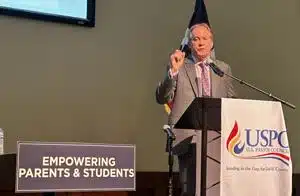(The Center Square) – Another year and it’ll be a decade since work began on the Dakota Access Pipeline, when local protests grew into a national phenomenon that residents of Morton County, North Dakota, will never forget.
Dakota Access, LLC, a subsidiary of Dallas-based Energy Transfer, began installation of the Dakota Access Pipeline in 2016. The 1,172-mile pipeline that stretches from the Bakken oil fields of North Dakota and ends in Illinois was constructed on nearly 99% privately owned land – except for a segment running under the Missouri River and managed by the U.S. Army Corps of Engineers.
That same segment is half a mile north of the Standing Rock Sioux Reservation. In April 2016, a small group of Sioux set up Sacred Stone Camp, a camp to protest the installation of the pipeline under the river on unceded treaty land for fear that the pipeline could leak and contaminate the river and water supply. They also said the pipeline would disrupt sacred burial grounds and other culturally relevant sites.
With funding and other support from environmental activist group Greenpeace and others, the protest grew and eventually attracted international media attention, especially when clashes with law enforcement became violent. Over 100,000 people descended on rural North Dakota in less than a year, many from other states and possibly some from abroad, according to locals.
Energy Transfer sued Greenpeace, blaming it for the escalation of the protests that delayed completion of the project by five months. The company says the delay cost them lost profits and shareholder value. It’s suing Greenpeace for $300 million.
The trial over the civil lawsuit began last month, and jurors are in their second day of deliberations Wednesday.
During the trial’s closing arguments, lead counsel for Energy Transfer Trey Cox revisited unsavory scenes from the protests – protestors lobbing “human feces, water bottles full of urine, burning logs” and other items at law enforcement and security, pouring sand in the engines of construction equipment, cutting wires and slitting the tires of police vehicles – arguing it was tied to Greenpeace’s involvement and influence.
The Center Square spoke to community members about their memories of the protests.
“It was a hard time for our community, it really was,” said Patricia Camisa, a 36-year-old small business owner in Mandan, Morton’s County seat. “It was an unfortunate event for I think all parties involved.”
Camisa told The Center Square her husband served as civilian staff for the Mandan Police Department at the time, enforcing municipal codes for things like property maintenance. But he still wore a kind of officer uniform, which made Camisa nervous.
As her husband wasn’t a sworn officer, he didn’t carry any form of protection – not even pepper spray – but his name was listed on the department’s website. Law enforcement reported seeing death threats against officers on social media during the protests.
“[His uniform] is a different color, but from a distance, it still looks like all the rest,” Camisa said.
Meanwhile, Camisa changed her last name back to her maiden name on social media. She said they also noticed people near their house that weren’t normally there.
“We had random people driving down our back alleyway at our house, so it was kind of a scary time,” Camisa told The Center Square.
Another woman, a retired 65-year-old long-time Mandan area resident who asked that The Center Square not reveal her identity, said she remembered protesters loitering in front of deputies’ houses on her street.
“There were two different houses in that neighborhood where Morton County deputies live, and they were stalking those people,” she told The Center Square. “And yes, I personally saw frickin’ protesters outside of that deputy’s house taking pictures of his children.”
The same woman recalled damage to a cemetery where a family member was buried.
Multiple sources reported stories, some from clients and some from friends, of cut fences and peoples’ livestock or pets going missing.
Several sources mentioned that everyone has a right to peaceful protest and they weren’t sure they opposed the protest outright, but nearly everyone The Center Square interviewed indicated that what ultimately happened was a disaster. After months of multiple headline-making aggressive interactions with law enforcement (for which the protesters blame law enforcement, and law enforcement blames the protesters) and a delayed permit from the Army Corps, President Donald Trump took office and issued a memorandum ordering the granting of the permit. Law enforcement arrested some of the last remaining protesters on Feb. 23, 2017, and reported that the camp had been “officially cleared of all protest activity,” according to The Guardian.
Estimates of the trash left at the site (including tents and temporary dwellings) range widely, from 9.8 million to 48 million pounds. North Dakota filed a lawsuit in 2019 seeking $38 million in reimbursements for law enforcement and cleanup expenses related to the DAPL protests.
Jon Gross, a local tattoo shop owner, said he had friends involved in the initial protest and isn’t particularly supportive of the pipeline, though he acknowledges pipelines are a safer way of moving crude oil than trucks or trains. He still has questions about the why and how of it all – why the Corps allowed the camp on federal land, why the protest grew so large and attracted so many people from out of state, why U.S. marshals were brought in to help deal with the protests, why the severe crackdown from law enforcement and who’s really at fault.
“The whole question of what really went on there is never going to get answered, is it?” he told The Center Square. “Here we are, we’re still having to deal with this.”
“It ended up in an absolute mess,” Gross said.
North Dakota’s lawsuit is still ongoing. A Morton County jury is currently in deliberations over a lawsuit Energy Transfer brought against environmental advocacy group Greenpeace, while a lawsuit between the Standing Rock Sioux tribe and the Corps and other lawsuits involving law enforcement continue.



















































